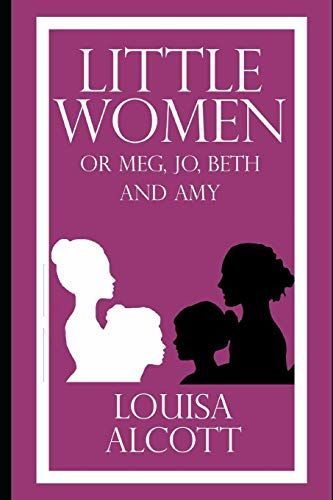
Little Women (illustrated) by Louisa M. Alcott Meg, Jo, Beth, and Amy
Little Women is a novel by American author Louisa May Alcott (1832-1888) which was originally published in two volumes in 1868 and 1869. Alcott wrote the book over several months at the request of her publisher. The story follows the lives of the four March sisters-Meg, Jo, Beth, and Amy-and details their passage from childhood to womanhood. It is loosely based on the lives of the author and her three sisters. Scholars classify it as an autobiographical or semi-autobiographical novel.Little Women was an immediate commercial and critical success, with readers demanding to know more about the characters. Alcott quickly completed a second volume (titled Good Wives in the United Kingdom, although this name originated from the publisher and not from Alcott), and it was also successful. The two volumes were issued in 1880 as a single novel titled Little Women.Alcott wrote two sequels to her popular work, both of which also featured the March sisters: Little Men (1871) and Jo's Boys (1886). The novel addresses three major themes: "domesticity, work, and true love, all of them interdependent and each necessary to the achievement of its heroine's individual identity. According to Sarah Elbert, Alcott created a new form of literature, one that took elements from Romantic children's fiction and combined it with others from sentimental novels, resulting in a totally new format. Elbert argues that within Little Women can be found the first vision of the "All-American girl" and that her various aspects are embodied in the differing March sisters.The book has frequently been adapted for stage and screen.In 1868, Thomas Niles, the publisher of Louisa May Alcott, recommended that she write a book about girls that would have widespread appeal. At first she resisted, preferring to publish a collection of her short stories. Niles pressed her to write the girls' book first, and he was aided by her father Amos Bronson Alcott, who also urged her to do so. Louisa confided to a friend, "I could not write a girl's story knowing little about any but my own sisters and always preferring boys", as quoted in Anne Boyd Rioux's Meg Jo Beth Amy, a condensed biographical account of Alcott's life and writing.In May 1868, Alcott wrote in her journal: "Niles, partner of Roberts, asked me to write a girl's book. I said I'd try. Alcott set her novel in an imaginary Orchard House modeled on her own residence of the same name, where she wrote the novel. She later recalled that she did not think she could write a successful book for girls and did not enjoy writing it.[9]:335- "I plod away," she wrote in her diary, "although I don't enjoy this sort of things." By June, Alcott had sent the first dozen chapters to Niles, and both agreed these were dull. But Niles' niece Lillie Almy read them and said she enjoyed them. The completed manuscript was shown to several girls, who agreed it was "splendid." Alcott wrote, "they are the best critics, so I should definitely be satisfied." She wrote Little Women "in record time for money," but the book's immediate success surprised both her and her publisher.According to literary critic Sarah Elbert, when using the term "little women", Alcott was drawing on its Dickensian meaning; it represented the period in a young woman's life where childhood and elder childhood were "overlapping" with young womanhood. Each of the March sister heroines had a harrowing experience that alerted her and the reader that "childhood innocence" was of the past, and that "the inescapable woman problem" was all that remained.Other views suggest that the title was meant to highlight the unfair social inferiority, especially at that time, of women as compared to men, or, alternatively, describe the lives of simple people, "unimportant" in the social sense.